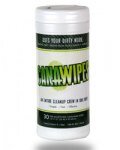Trimming Cannabis
A step-by-step guide on trimming cannabis buds. Learn the most popular techniques - wet trimming vs dry trimming, along with the necessary trimming tools to get the job done.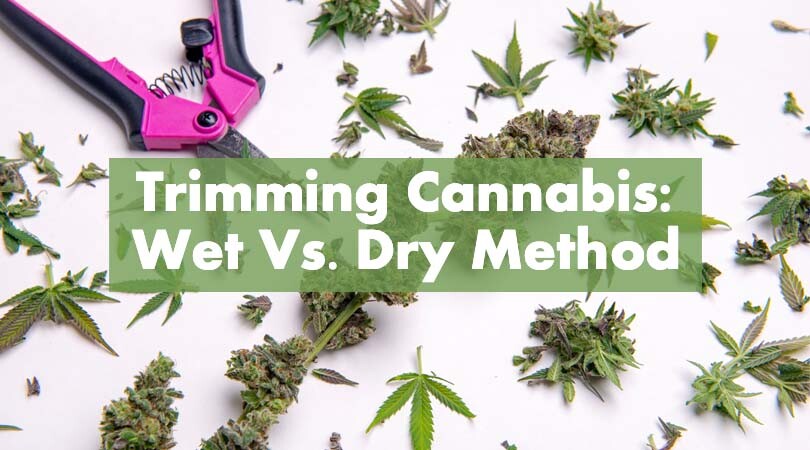 Whether growing one weed plant or a roomful — nothing is more exciting than harvest day.
Whether growing one weed plant or a roomful — nothing is more exciting than harvest day.
Regardless of how amazing your marijuana crop is, everything depends on the next step: trimming. From overall bag appeal to flavor and everything in between — trimming is the deciding factor between mediocre and top-shelf weed.
Although it may feel daunting at first, we’re here to guide you every step of the way to ensure the best trim job possible. As you read below, you’ll discover everything you need to know about trimming cannabis.
What is The Trimming Process, and Why Does it Matter?
First, let’s talk about why we trim or manicure our marijuana flowers.
Trimming is the act of removing excess leaf matter from the cannabis flower. Flowers and leaves on cannabis plants are two separate things.
Cannabis plants exhibit two leaf types:
- Fan leaves (primary leaves)
- Sugar leaves (secondary leaves)
Cannabis cultivators discard the large fan leaves. However, the “sugar leaves” are trimmed and saved because they exhibit trichome coverage due to their proximity to the buds. In either case, the overarching goal is to remove as much leaf matter as possible.
Remember, you want to smoke cannabis buds — not leaves!
Therefore, you must learn how to manicure the cannabis flowers to perfection by using specially crafted trimming scissors or trimming machines.
By trimming marijuana flowers, your buds will:
- Increase in bag appeal
- Taste better (less chlorophyll)
- Smell better
- Enhance overall potency
In other words — it pays to trim your weed!
The Two Primary Marijuana Trimming Methods
Before you begin to trim your resin-coated flowers — you must understand the difference between wet and dry trimming.
As you’ll soon learn, wet and dry trimming are the two primary methods to trim cannabis. Each method has its pros and cons, so you must understand each to suit your needs.
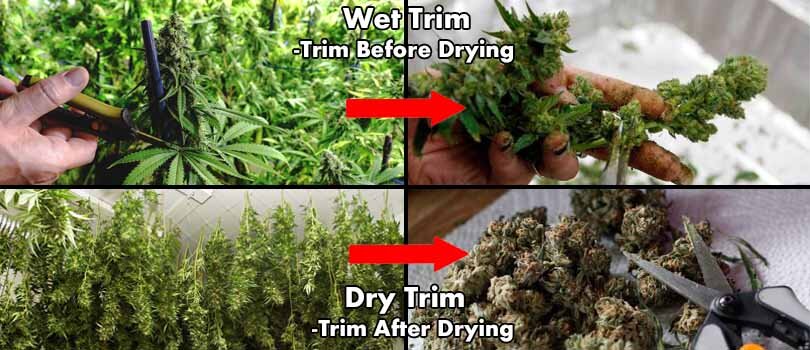
Each method has its pros and cons, so you must understand each to suit your needs.
Wet Trimming Cannabis
Wet trimming requires cultivators to trim the leaves from the cannabis buds immediately after harvest.
Overall, wet trimming is done before the drying process — hence the name wet. Below, you’ll discover the advantages of the wet trimming method:
Wet Trimmed Cannabis is Less Prone to Mold
One of the significant benefits of wet trimming weed is that it’s less prone to mold outbreaks.
Whether you live in a high humidity zone or not, wet trimming cannabis removes the bulk moisture from the buds. Therefore, cannabis flowers harvested with the wet trim method are less likely to become moldy.
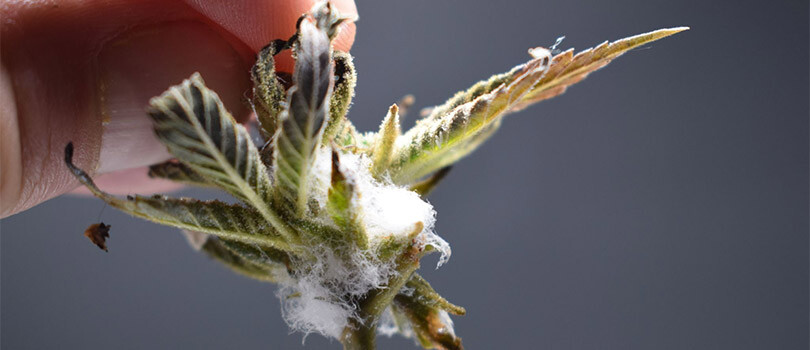
Wet trimming cannabis removes the bulk moisture from the buds.
Wet Trimmed Cannabis Results in Quick Drying Buds
Ultimately, wet trimming is best used when time is of the essence.
There is significantly less moisture on the buds by removing the primary and secondary leaves immediately after harvest. Therefore, the drying process is done in a snap.
Wet Trimmed Weed Retains More Trichomes
Trichomes are much more stuck to the flower’s surface immediately after harvest.
Therefore, cultivators who want to retain more trichome content choose the wet trimming method.
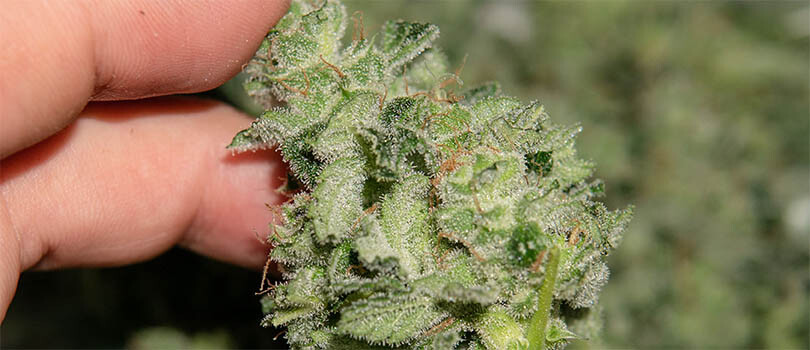
Trichomes are much more stuck to the flower’s surface immediately after harvest.
Wet Trimming Requires Less Space for Drying
The wet trimming method requires less space for drying because it removes all of the leaves immediately after harvest.
Although it may not seem like it at first, cannabis leaves take a large amount of space. Therefore, removing the leaves before the drying stage will provide up to 50% more space.
Wet Trimmed Buds are Larger
One of the great aspects of wet trimming is the larger bud size.
Overall, many cannabis cultivators enjoy wet trimming because it adds value to the overall bag appeal.
You Can Use Different Trimming Tools With the Wet Trim Process
Unlike the dry trimming process, which requires a delicate touch, the wet trimming process allows you to use a wider range of trimming tools.
From trimming machines to trimming scissors, you are not limited when harnessing the wet trimming method.
As you can see — there are many benefits to the wet trimming technique. Below, we’ll discuss the disadvantages of the wet trimming method:
Wet Trimmed Buds Are Fluffy
Although wet trimmed weed is larger — it comes at a cost.
Overall, wet trimmed weed does not tighten up, meaning it does not shrink in size. As such, wet trimmed weed is typically fluffier when compared to dry trimmed buds.
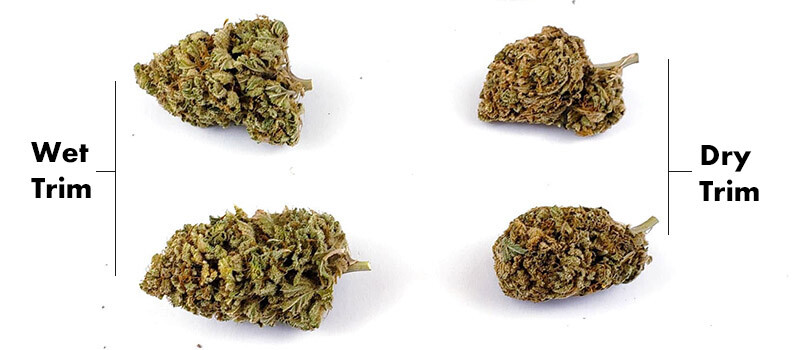
On the left are wet trimmed buds, and as you can see, the wet trimmed weed does not tighten up.
Wet Trimmed Flowers May Dry Too Fast
One downside of wet trimming weed flowers is that they may dry too fast.
Cannabis that dries too fast is prone to a reduced terpene profile. In some cases, cannabis cultivators who allow their wet trimmed flowers to dry too fast experience a hay-like taste.
Therefore, cannabis cultivators must ensure stable temperature, RH, and airflow immediately after trimming.
Wet Trimming Cannabis is Messy
Trimming is all fun and games until you’re 3-hours in with no end in sight.
From your fingers to your trimming scissors — everything is caked in sticky resin. Overall, wet trimming weed is messier than dry trimming because it is still fresh, making it more challenging to handle.
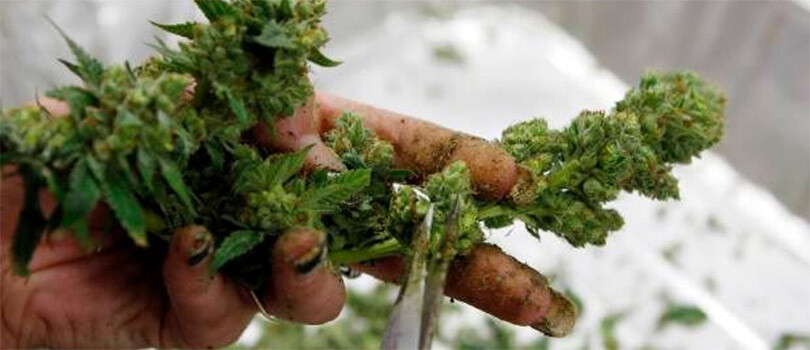
Expect everything to get caked in sticky resin.
Dry Trimming Cannabis
Overall, the dry trimming technique is a two-part process.
First, the cannabis plant(s) is dried for several days. Second, the flowers are trimmed and manicured.
Although dry trimming sounds more tedious — it’s the preferred method of cannabis connoisseurs worldwide. Below, we’ll describe the advantages and disadvantages of dry trimming cannabis.
Let’s start with the advantages of dry trimming weed:
Dry Trimming Weed Breaks Up the Trimming Process
If you choose to use the dry trimming method — you do not need to start trimming immediately.
Dry trimming splits the workload into two parts: first drying and then trimming. Therefore, the dry trimming method is not as urgent as the wet trimming technique.
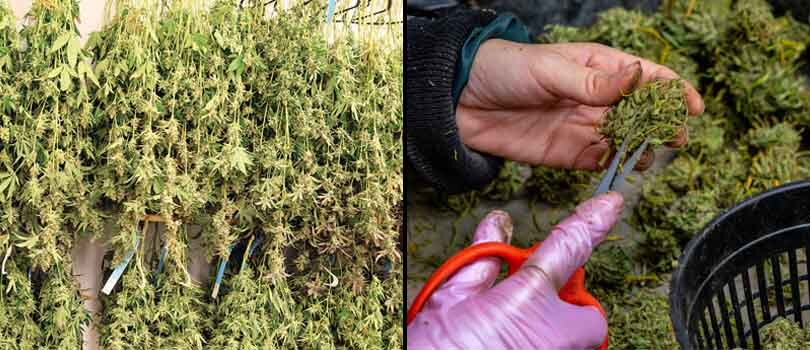
Dry trimming splits the workload into two parts: first drying and then trimming.
Dry Trimming Results in Denser Buds
By allowing your buds to dry for 1-3-days before trimming, the buds will shrink in size as they lose moisture.
Naturally, the flowers become denser (tighter) during the initial drying process. From increased bag appeal to a smoother burn, the dry trimming process is the best way to produce dense weed flowers.
Dry Trimming Results in Higher Terpene Retention
Terpenes are volatile aromatic compounds that diminish when exposed to air, heat, light, and humidity.
When using the dry trimming technique, the cannabis leaves wrap around the flowers, creating a perfect environment. By drying slowly and evenly, dry trimmed cannabis retains the majority of its terpene content, resulting in delicious and aromatic buds.
Dry Trimming is Ideal For Hash Makers
If you’re a hash lover — the dry trimming process is the best method to use to extract individual trichome glands.
By using a hash tumbler (pollen extractor/dry sift tumbler), you can quickly generate top-shelf dry-sift hash.
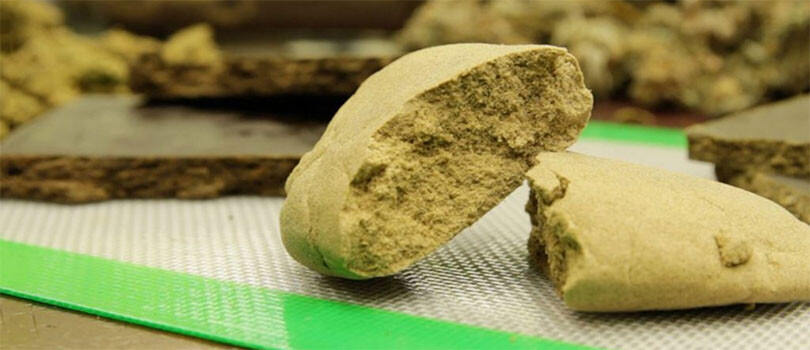
If you’re a hash lover — the dry trimming process is the best method to use to extract individual trichome glands.
Dry Trimming Results in Beyond Top-Shelf Weed
Because the dry trimming process requires you to be gentle — the results are beyond top-shelf.
You can use a dry trimming machine, but precision trimmers get the perfect cut. Overall, cannabis enthusiasts that grow small batches prefer to use the dry trim process.
Now, let’s take a look at the disadvantages of using the dry trimming method on your crop:
Dry Trimming Requires a Specific Environment
To get the most out of the dry trimming method, you must provide an environmentally controlled space.
Since the cannabis flowers are left to dry with attached leaves, there is an increased chance of mold. Therefore, the humidity range must be between 30-40%, and the temperature should be no more than 80F.
Dry Trimming Requires More Space
You need more space than the wet trimming method since you don’t cut off any leaves during the drying process.
Remember, primary leaves can extend 3-7″ in length and account for a bulk of the plant’s weight. Additionally, you can’t let cannabis branches touch each other, or you will increase the likelihood of mold.
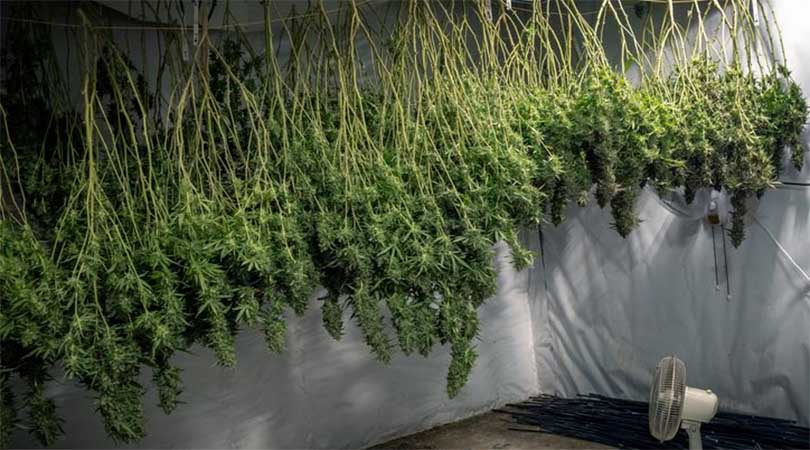
You need more space than the wet trimming method since you don’t cut off any leaves during the drying process.
Dry Trimming Requires More Time
Once the flowers are adequately dry — you need to trim the leaves carefully.
Remember, dry trichomes break easily when handled roughly. Therefore, the dry trimming process is much more tedious and time-consuming.
Which is The Best Trimming Technique?
With countless cannabis harvests under my belt — you’d think I have an answer to this question.
My answer, however, is it depends on the situation.
To make the decision process easier, here’s a list of generalized situations where I choose the dry or wet trimming method.
When to Use The Dry Trimming Method
- When you want ultra top-shelf cannabis
- When you prefer to trim with scissors (such as micro tips and shears)
- When you are trimming a small weed batch
When to Use The Wet Trimming Method
- When you use a trimming machine
- When you need your weed to dry fast
- When you are trimming a significant amount of weed
Although there are more situations to choose from, these examples are what I ask myself before I begin the trimming process.
The Tools of The Trimming Trade
So, you’re ready to trim your cannabis flowers — great!
Aside from choosing the best trimming method — you need to select the best trimming tools for the job.
Below, we’ll list and describe essential trimming tools to chop, cut, and manicure your top-shelf buds.
- Handheld trimming scissors (micro tips, shears, curved, and snips)
- Trimming machines (handheld, commercial, stand up, bowl and bag, small-scale)
- Trim trays and bins
- Gloves
- Scissor cleaner
- Trim station or cart
Trimming Scissors
First, let’s talk about the most classic cannabis trimming tool — scissors.
Trimming scissors have many different styles, such as
- Micro tips
- Shears
- Curved tips
- Snips
Generally, shears (larger blades) are used to chop thick branches to make the cannabis flowers easier to handle. Alternatively, micro tips are for manicuring deep inside the bud to remove as much leaf matter as possible.
Additionally, curved tips are for hard-to-reach angles. Lastly, snips are used to remove primary leaves quickly.
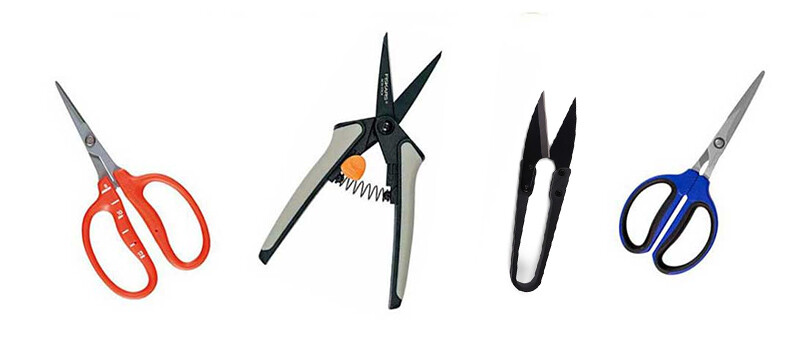
Trimming scissors have many different styles.
Trimming Machines
Trimming Machines allow cultivators to trim cannabis flowers in half (or less) the time compared to traditional trimming scissors.
However, trimming machines do not offer the human touch associated with high-end trim jobs. Ultimately, trimming machines are geared towards users with limited time or massive harvests.
There are a few different types of trimming machines, such as
- Wet trimming machines
- Dry trimming machines
Wet trimming machines come in many forms, from large-scale to handheld electric trimmers.
Overall, trimming machines trim fresh or dry cannabis leaves without harming the flower.
Read: The Best Weed Trimming Machines
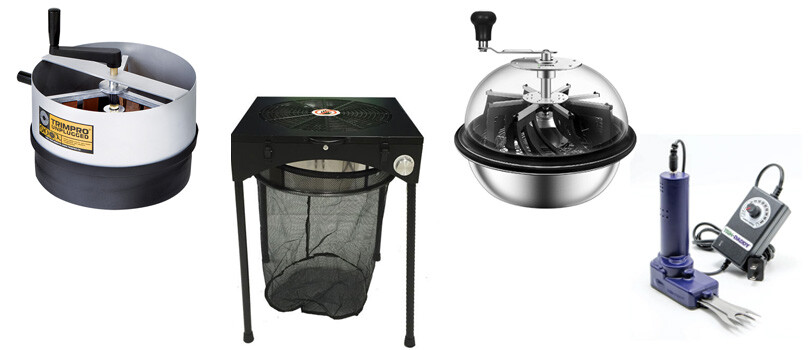
Trimming machines are geared towards users with limited time or massive harvests.
Gloves
Not all trimming gloves are created equal!
First and foremost, you want to buy gloves that are not coated in non-stick powder. In my experience, there’s no better option than thick Nitrile gloves — plus, the black color looks cool!
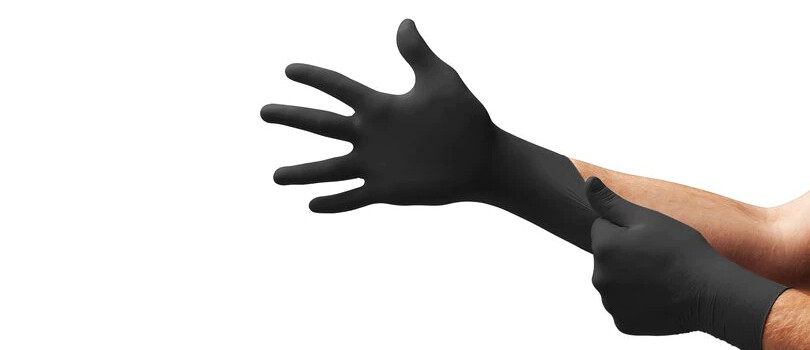
There’s no better option than thick Nitrile gloves.
Scissor Cleaner
If you choose to trim weed by hand — you’re going to need a scissor cleanser.
As the resin cakes the scissor’s blades, your ability to perform accurate cuts decreases. Therefore, gentle scissor cleaner is a must-have tool for any cannabis cultivator.
Trim Station or Cart
If you don’t have an available desk — you’re going to need a trim station or cart.
Trim stations or carts are mobile platforms that allow cannabis cultivators to trim weed while standing up or sitting down. Since they are mobile, you can push the cart with you to a new location.
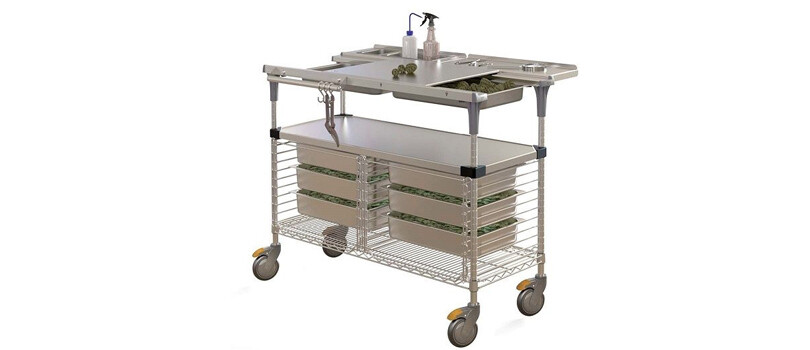
A trim station is an important place to get your trimming done.
How to Dry Trim Cannabis by Hand in Six Easy Steps
Alright, enough talk and more action! It’s time to sit down and learn how to dry trim your cannabis the right way.
Here’s a list of tools that you’ll need to get the job done:
- Trimming scissors
- Trimming gloves
- Trimming tray or trim station
- Scissor cleaner
- Oscillating fan
- Thermometer/hygrometer combo
- Clothes hangers or clothesline
- AC/Dehumidifier (optional)
- A room, closet, or empty grow tent
- Rubber Bin(s)
- Music
- Snacks
Step One: Harvest Your Cannabis Plants
If this is your first time harvesting cannabis plants, head over to our detailed guide on How to Harvest Cannabis Plants. If you already harvested your star-spangled weed plants, head over to step two.
Step Two: Begin the Drying Process
Drying cannabis is easy as long as you’ve read our in-depth guide on Drying Cannabis. If you’ve already dried (or are in the process of drying) your cannabis — head over to step three!
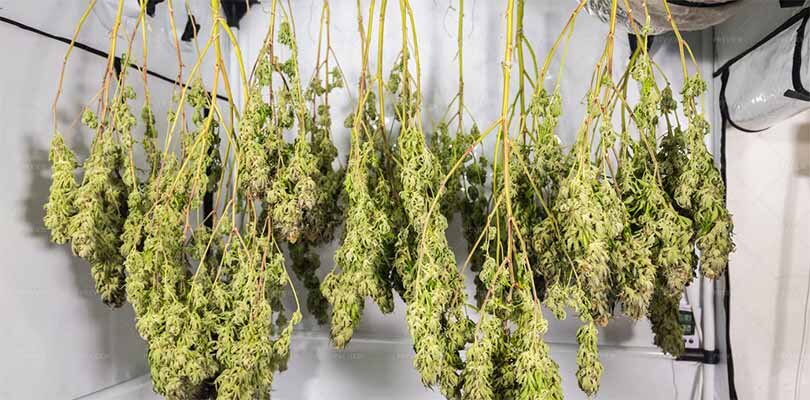
Drying cannabis is a cinch.
Step Three: Setting up Your Trim Station
Trimming weed is fun but quickly becomes monotonous — especially if you yield pounds of trichome-covered buds.
Aside from the essential trimming tools, grab snacks, water, a joint or two, and your favorite playlist. Believe us, trimming takes a lot longer than expected!
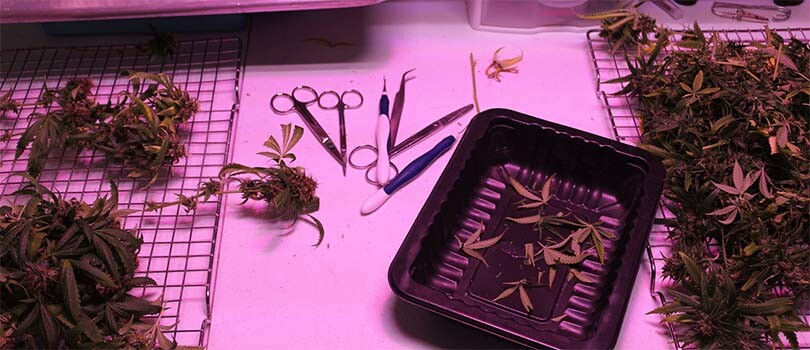
Aside from the essential trimming tools, grab snacks, water, a joint or two, and your favorite playlist.
Step Four: Trimming (Primary) Fan Leaves
As you look at the dry cannabis buds, you’ll notice the primary and secondary leaves have withered and encapsulated the buds.
To keep things organized, select a single branch. We recommend trimming one branch at a time because you may be overwhelmed when an entire cannabis plant is on the trimming tray.
Now that you have a single branch on the trimming station, trim the large primary leaves first.
Use your trimming scissors to snip the base of the leaf — primarily at the stipule where the leaf grows from the branch. Continue to do so until all of the primary fan leaves are removed and thrown into a plastic bin.
Once you’ve done this to every branch, you’ve completed the first round of “dry” trimming.
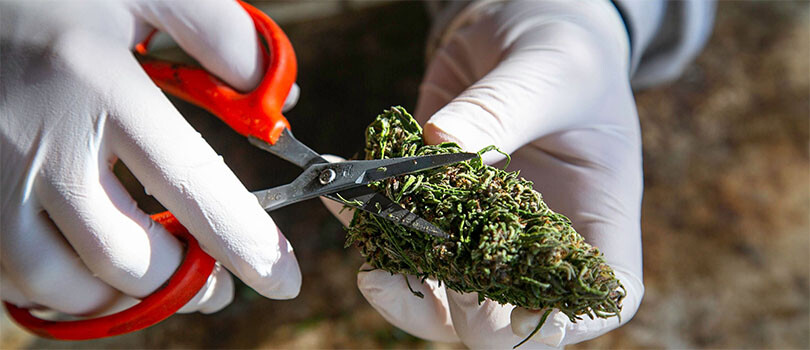
Use your trimming scissors to snip the base of the leaf — primarily at the stipule where the leaf grows from the branch.
Step Five: Trim the Sugar (Secondary) Leaves
Here’s how to trim the sugar leaves from your buds:
- take a single branch and look at the small secondary leaves that grow out of the cannabis flower.
- Use the pruning snips to cut the petiole or the stipule of the secondary leaves if visible.
- If you cannot cut the sugar leaf’s base, trim the outermost portion of the leaf without cutting the calyx.
As you remove the sugar leaves, place them into a separate bin to make hash later. Once you’ve done this to each branch, the buds will finally look like weed!
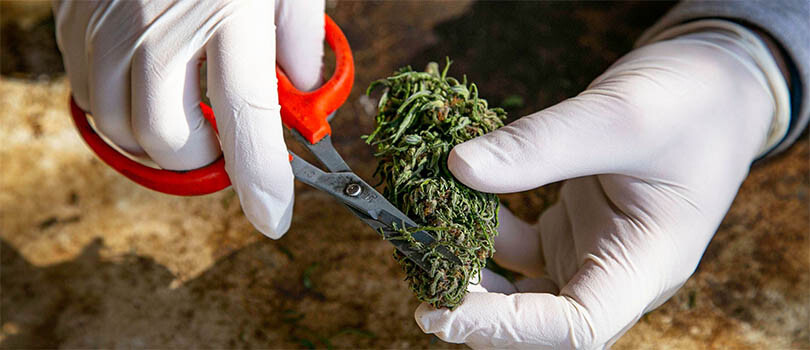
Remember – if you cannot cut the sugar leaf’s base, trim the outermost portion of the leaf without cutting the calyx.
Step Six: Manicure Your Buds
The last step is to remove the buds from the branches and look over the buds for remaining secondary leaves.
Take a single branch that’s loaded with buds and begin from the bottom. Use your trimming scissors and cut the base of the bud. Once the bud is free, place it into a tray.
Once your tray is full of buds — it’s time to do a final manicure.
At this point, go through each flower and remove any remaining secondary (sugar) leaves that you missed or were covered by the stems of the branch.
Once done, your cannabis buds will shine bright with trichomes and look as if they’re ready for a High Times cover shoot!
Once your buds are fully manicured, place them into glass jars to kick off the curing process.
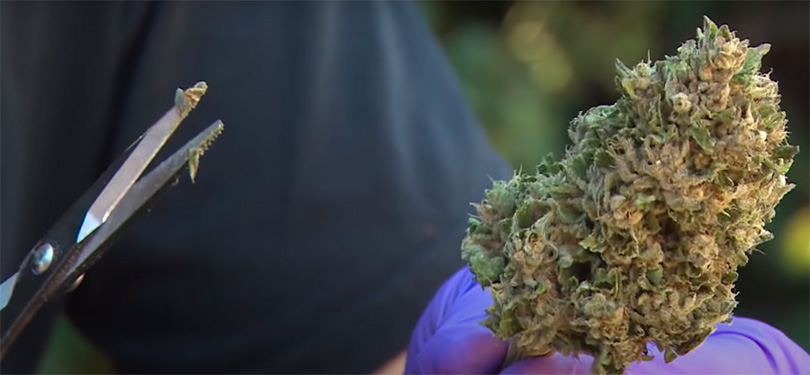
The last step is to remove the buds from the branches.
How to Wet Trim Cannabis by Hand in Ten Easy Steps
Now, let’s discuss how to wet trim cannabis flowers in ten easy steps.
Before we begin, here’s a list of tools that you’ll need:
- Trimming scissors
- Trimming machine (optional)
- Trimming gloves
- Scissor cleaner
- Plastic bin
- Trimming tray
- Trimming station or cart
- Music
- Snacks
- Water
Now, let’s start trimming those fresh green buds!
Step One: Set Up Your Trimming Station
Whether it’s on your couch or desk — have everything you need within arms reach. Additionally, it helps to sanitize your workstation to ensure your buds get the royal treatment.

Whether it’s on your couch or desk — have everything you need within arms reach.
Step Two: Separate the Branches From the Plant
Next, slap on a pair of thick Nitrile gloves and pick up your pruning shears — it’s time to start chopping.
The point of the initial trimming stage is to cut your cannabis plant into manageable pieces. This is done by using your trimming shears to cut each branch to make the next step easy.
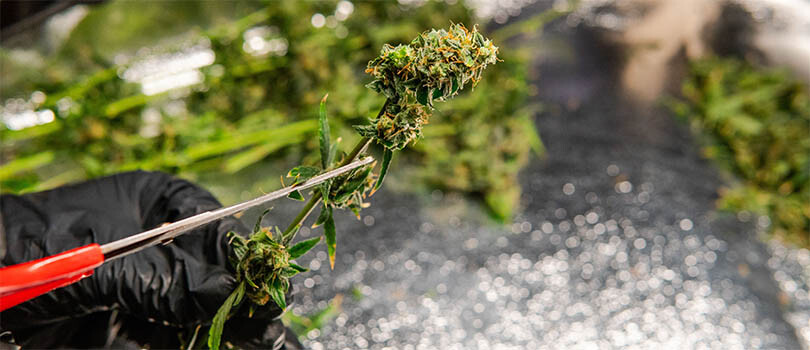
The point of the initial trimming stage is to cut your cannabis plant into manageable pieces.
Step Three: Remove the Primary Leaves
Now, put down your trimming shears and bring out the micro tips or snips to remove the bulk of the primary leaves.
Remember, the primary leaves are the largest leaves on the plant. Discard all the primary leaves into a plastic bin.
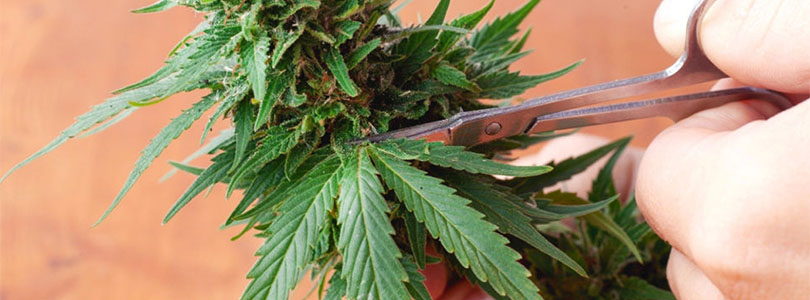
bring out the micro tips or snips to remove the bulk of the primary leaves.
Step Four: Remove the Sugar (Secondary) Leaves
Begin trimming the secondary (sugar) leaves.
Depending on how frosty your cannabis flowers are, you’ll need to clean all the resin buildup from your scissors periodically.
Use your resin cleaner to clear off all the sticky resin. Remember, gunked-up trimming scissors are inefficient and provide a sketchy trim job.
In my experience, it helps to have a second pair of trimming scissors to avoid any slowdowns during the trimming process.
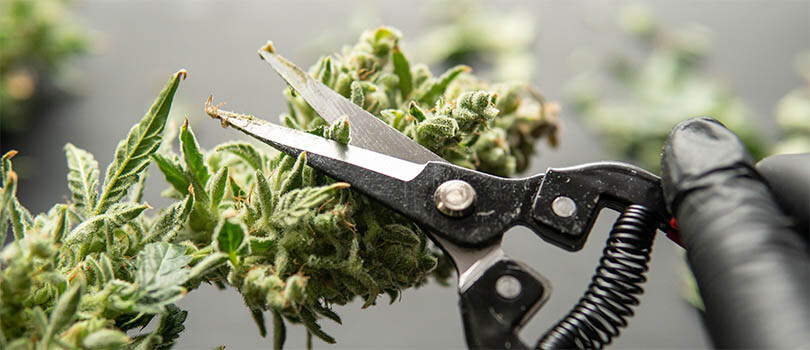
Depending on how frosty your cannabis flowers are, you’ll need to clean all the resin buildup from your scissors periodically.
Step Five: Gather the Secondary Leaves
Next, gather all the trimmed sugar leaves and place them into another plastic bin.
Later, you can use these secondary leaves to make hash or cannabutter. In any case, stash the secondary leaves for safekeeping until you have the time to process them.
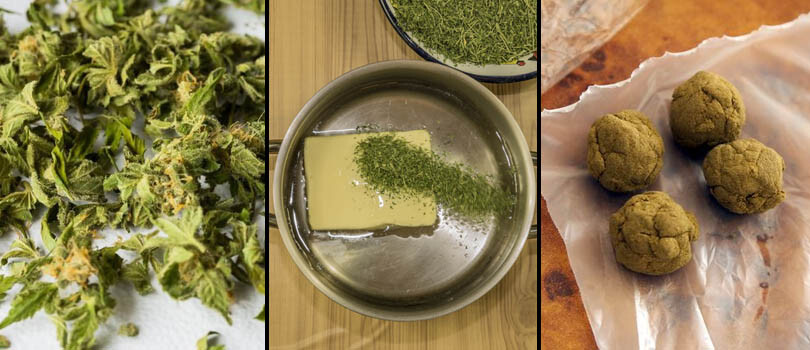
Later, you can use these secondary leaves to make hash or cannabutter.
Step Six: Remove the Buds From the Branch
Once you’ve trimmed most secondary leaves from the cannabis buds — it’s time to snip the buds off the branch.
You must be careful not to cut into the buds during this process. Instead, use your micro tips to cut where the bud’s stem meets the branch.
Once done, you’ll have a pile of fresh cannabis buds on your trimming tray.
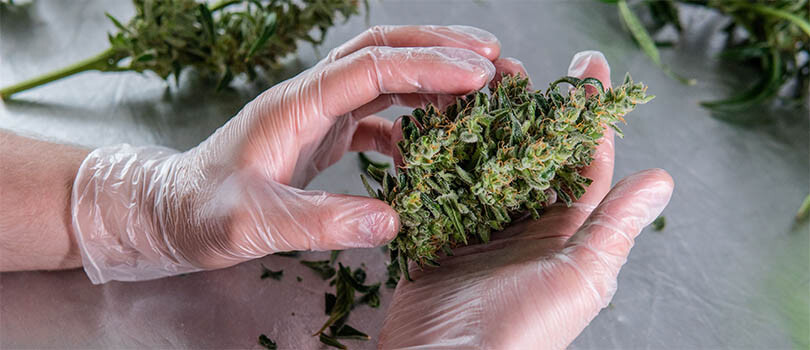
Once you’ve trimmed most secondary leaves from the cannabis buds — it’s time to snip the buds off the branch.
Step Seven: Manicure the Buds
It’s time for the manicuring process once you’ve separated the buds from the branches.
If you have yet to clean your trimming scissors — do so now. The manicuring step requires ultra-precise cuts that will make or break your bud’s bag appeal.
Overall, use micro-tips to cut the sugar leaves as close to the bud without cutting the calyx. By doing so, you’ll reveal the true shape of the bud and show off its eye-popping traits.
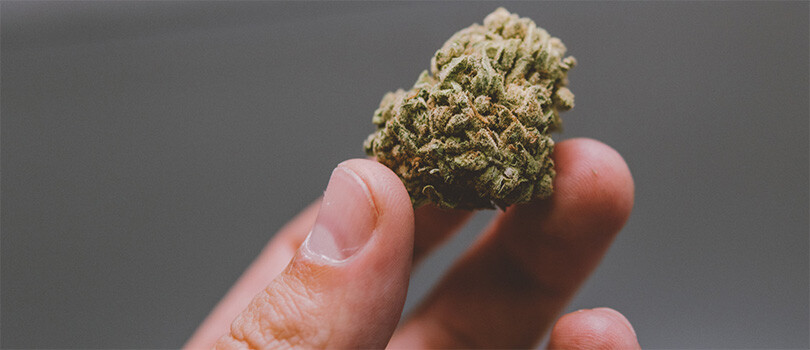
Overall, use micro-tips to cut the sugar leaves as close to the bud without cutting the calyx.
Step Eight: Clean Your Trimming Station and Tools
One of the last steps during the wet trimming process is the clean-up.
This step includes throwing away primary leaves and stashing away secondary (sugar) leaves. Additionally, throw your trimming scissors into a cleaning solution to prepare them for the next harvest.
Step Nine: Double-Check Your Buds
Next, do an overview of your trimmed buds.
Did you miss any stand-out sugar leaves? More leaf matter produces excess moisture, which stalls the drying and curing process. Aside from the flushing technique, removing sugar leaves is vital to ensuring flavorful and aromatic cannabis.
Step Ten: Prep Your Buds for The Drying and Curing Process
Last but not least, gather your trimmed weed in preparation for the next steps — drying and curing!
If this is your first time drying and curing marijuana, head over to our guides on how to dry weed and how to cure weed!
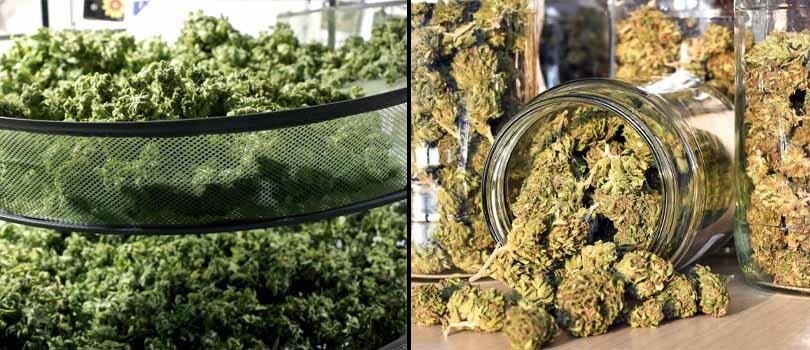
Last but not least, gather your trimmed weed in preparation for the next steps — drying and curing!
Wet or Dry Trimming Cannabis With a Machine
Above, we outlined the steps to wet or dry trim marijuana by hand.
There are many options to trim your weed, from handheld electric trimmers to commercial-grade trimming machines without getting your hands dirty!
Here are a few essential tips when using a bud trimming machine:
- Always remove the buds from the branch
- Choose a machine trimmer that fits the size of your harvest
- Pick marijuana trimming machines that can trim different bud sizes
- Always clean and maintain your bud trimming machine
If you’d like to learn more about marijuana trimming machines — head over to our in-depth article on Bud Trimming Machines.



